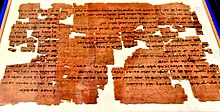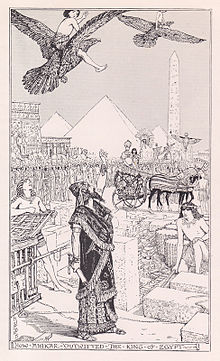Akụkọ banyere Ahikar


Akụkọ nke Aḥiqar, nke a makwaara dịka Okwu nke Aḥuqar، bụ akụkọ mbụ e gosipụtara na Imperial Aramaic site na narị afọ nke ise BCE na papyri sitere na Elephantine, Ijipt, bụ nke e kesara n'ọtụtụ ebe n' Etiti nakwa Nso nso nke ọwụwa anyanwụ.[1][2] A kọwawo ya dịka otu n'ime 'akwụkwọ mba ụwa' mbụ nke akwụkwọ ụwa".[3]
Onye isi, Aḥiqar, kaara abụ onye isi ala nke ndị eze Asiria Sennacherib na Esarhaddon. Naanị mbadamba ụrọ cuneiform nke Babilọn nke oge ochie sitere na Uruk (Warka) kpọtụrụ aha Aramaean Aʹuʹaqār.[4] E dere aha ya n'asụsụ Aramaic Imperial na n'asụsụ Syriac ma sụgharịa ya dịka Aḥiqar, Arabic حَيْقَار Ḥayqār, Greek Achiacharos na Slavonic Akyrios yana ụdị dị iche iche na isiokwu ahụ dịka Armenian: Խիկար (Xikar), Ottoman Turkish Khikar, onye amamihe a maara na Near East oge ochie maka amamihe ya pụrụ iche.[5]
A maara ya dịka TAD C1.1, ma depụta ya dịka Berlin P. 13446A-H, K-L (Egyptian Museum of Berlin) na Pap. No. 3465 = J. 43502 (Egyptian Museum of Cairo).
Akọma Akụkọ
[dezie | dezie ebe o si]N'akụkọ ahụ, Ahikar bụ onye isi akụkọ ifo nye eze Asiria Sennacherib na Esarhaddon.[6] Ebe ọ na-enweghị nwa nke ya, ọ kuchiri nwa nwanne ya nwoke Nadab / Nadin, ma zụlite ya ka ọ bụrụ onye nọchiri ya. Nadab/Nadin ji enweghị ekele mee atụmatụ igbu nwanne nna ya meworo agadi, ma mee ka Esarhaddon kwenye na Ahikar agbaala emeela arụ. Esarhaddon nyere iwu ka e gbuo Ahikar na nzaghachi, ya mere e jidere Ahkar ma tụọ ya mkpọrọ ka ọ na-echere ntaramahụhụ. Otú ọ dị, Ahikar na-echetara onye ogbugbu ahụ na Ahkar zọpụtara onye gburu ya site na ọdịnihu yiri nke ahụ n'okpuru Sennacherib, ya mere onye na'ogbugbu ahụ gbukwara onye mkpọrọ kama, ma mee ka Esarhaddon chee na ọ bụ ozu Ahikara.
Ihe odide ndị fọdụrụnụ anaghị adịgide karịa nke a, mana a na-eche na njedebe mbụ nwere Nadab / Nadin ka a ga-egbu mgbe a gbanwere Ahikar. Ihe odide ndị ọzọ na-egosi Ahikar ka ọ na'ebe zoro ezo iji nye eze Ijipt ndụmọdụ maka Esarhaddon, wee laghachi na mmeri na Esahaddón. N'ihe odide ndị ọzọ, mgbe Ahikar lọtara, o zutere Nadab / Nadin ma weere ya iwe nke ukwuu, Nadap / Nadin wee nwụọ.
Mbipụta na nsụgharị
[dezie | dezie ebe o si]- Eduard Sachau, Aramäische Papyrus und Ostraca aus einer jüdischen Militärkolonie (Leipzig: J. C. Hindrichs, 1911), peeji nke 147182, pls. 400.
- Akụkọ nke Aḥiḳar sitere na Aramaic, Syriac, Arabic, Armenian, Ethiopic، Old Turkish, Greek na Slavonic Versions, nke F. Conybeare, J. Rendel Harrisl Agnes Smith Lewis, mbipụta nke abụọ (Cambridge: Cambridge University Press, 1913) archive.org
- A. Cowley, "Akụkọ nke Aḥiḳar," na Aramaic Papyri nke narị afọ nke ise (Oxford: Clarendon Press, 1923), peeji nke 204
- (1926) in Platt: The forgotten books of Eden. New York, NY: Alpha House, 198–219. (audiobook)
- The Say of Haykar the Sage nke Richard Francis Burton sụgharịrị
- James M. Lindenberger, The Aramaic Proverbs of Ahiqar (Baltimore: Johns Hopkins University Press, 1983).
- James M. Lindenberger, Ahiqar. A New Translation and Introduction, in James H. Charlesworth (1985), The Old Testament Pseudoepigrapha, Garden City, NY: Doubleday & Company Inc., Mpịakọta nke 2, (Mpịaka 1), IS ( Mpụka nke 2), peeji nke 494-507.[7]
- Ingo Kottsieper, Die Sprache der Aḥarsprüche (= Beihefte zur Zeitschrift für die altestamentliche Wissenschaft, 194) (Berlin: De Gruyter, 1990). ISBN 3-11-012331-2
- Bezalel Porten, Ada Yardeni, "C1.1 Aḥiqar," na Textbook of Aramaic Documents from Ancient Egypt, Mpịakọta nke 3 (Jerusalem, 1993), peeji nke 2357. ISBN 965-350-014-7
Ihe ndị e dere n'akwụkwọ
[dezie | dezie ebe o si]- ↑ Christa Müller-Kessler, "Ahiqar," in Brill’s New Pauly, Antiquity volumes, ed. by Hubert Cancik and Helmuth Schneider, English edition by Christine F. Salazar, Classical Tradition volumes ed. by Manfred Landfester, English Edition by Francis G. Gentry.
- ↑ The Story of Ahikar | Pseudepigrapha (en). Encyclopedia Britannica. Retrieved on 2021-01-23.
- ↑ Ioannis M. Konstantakos, "A Passage to Egypt: Aesop, the Priests of Heliopolis and the Riddle of the Year (Vita Aesopi 119–120)," Trends in Classics 3, 2011, pp. 83–112, esp. 84).
- ↑ J. J. A. van Dijk, Die Inschriftenfunde der Kampagne 1959/60, Archiv für Orientforschung 20, 1963, p. 217.
- ↑ The Story of Aḥiḳar from the Aramaic, Syriac, Arabic, Armenian, Ethiopic, Old Turkish, Greek and Slavonic Versions, ed. by F. C. Conybeare, J. Rendel Harrisl Agnes Smith Lewis, 2nd edition (Cambridge: Cambridge University Press, 1913) archive.org
- ↑ Perdue (2008). Scribes, Sages, and Seers: The Sage in the Eastern Mediterranean World (in en). Vandenhoeck & Ruprecht, 109. ISBN 978-3-525-53083-2. “The story of Ahikar, who is said to have served at the courts of Sennacherib and then Esarhaddon, and the sayings connected with his name were well known in the Ancient Mediterranean World.”
- ↑ Quote from the 1985 book: "[the translated Aramaic text is based on the oldest extant version] found in a single papyrus manuscript. It was discovered by the German exvators of ancient Elephantine in 1907. Catalogued by the Berlin State Museums as P. 13446, most of the manuscript remains in the museum's Papyrus Collection. Column vi was subsequent returned to Egypt along with a number of other papyri from Elephantine and it is now in the Egyptian Museum at Cairo, where it bears the catalogue number 43502." (pp. 480-479)
Njikọ mpụga
[dezie | dezie ebe o si]
- Akụkọ Ahikar
- The Story of Ahikar public domain audiobook at LibriVox
- AḤIḳAR na JewishEncyclopedia.com
- Purim Mbụ
- "Ihe ncheta nke Sennacherib na ọdịnala Aramaic"
